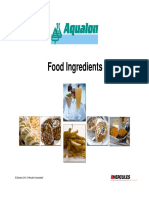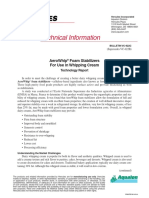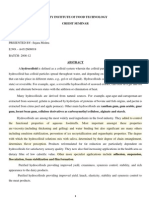Ice Cream With High Overrun
Ice Cream With High Overrun
Uploaded by
gutierrez_rgcCopyright:
Available Formats
Ice Cream With High Overrun
Ice Cream With High Overrun
Uploaded by
gutierrez_rgcCopyright
Available Formats
Share this document
Did you find this document useful?
Is this content inappropriate?
Copyright:
Available Formats
Ice Cream With High Overrun
Ice Cream With High Overrun
Uploaded by
gutierrez_rgcCopyright:
Available Formats
we aim to be the preferred partner commitment.
and supplier of quality products, application service and knowhow to regional and m u l t i - n a t i o n a l food companies. to Palsgaard l o y a l t y means that we act as a reliable and honourable business partner for our customers. we treat information confidentially and know how to keep a business secret. to Palsgaard r e s p o n s i b i l i t y means caring about the environment and being aware of our corporate social responsibility; we have a goal to be CO 2 neutral by 2020 and are members of SEDEX and RSPO. to Palsgaard c o m m i t m e n t means we are dedicated to getting the best results for our customers products - to the benefit of their customers. we care about our employees and have a declared aim that Palsgaard must be a pleasant place to work. Palsgaard we know that our most important resource is the k n o w - h o w and d e d i c a t i o n found in our employees. we are committed to getting the best results with our products in our pilot plants and in your facilities. at Palsgaard we dont sell standard solutions - we start with your needs. Palsgaard - Heart Working heart work is the best way to achieve success - let us help you get it. our products are produced according to the
in just three
words :
happy to share our expertise. our company values can be defined
are
confectionery, dairy, ice cream, margarine and fine foods - and we
e x p e r t s in e mul s i f i e rs and stabilizers for bakery,
we are
loyalty, responsibility and
Heart Working People
strictest quality criteria. we are experts
in emulsifiers and stabilizers and we are happy to share our
expertise with you. let our pilot plants help you shorten the step between idea
and
your new product.
way to succeed - let us help
heart work is the best
you do
Manufacturing high quality ice cream with high overrun
so.
Palsgaard Technical Paper, October 2011
By Hanne K. Ludvigsen, Product Manager, Ice Cream and Dairy Group, Palsgaard A/S.
Ice cream is a very common and loved dessert and snack around the world. Eating ice cream is perceived as a pleasure and a luxury treat. However, the full pleasure of eating ice cream requires a smooth and creamy product throughout the entire shelf-life. However, not only recipe and processing parameters influence the product quality as experienced by the consumer. Also during transportation and storage of the ice cream - from the factory via the shop to the consumer - a high risk of applying heat-shock with concomitant quality loss exists.
ness and smoothness as well as resistance to shrinkage and melting cannot be compromised as these properties are very closely linked to consumer preferences. Creaminess as well as melting resistance is related to the distribution of air cells in the product. A more uniform air cell distribution in the ice cream results in a creamier and slower melting ice cream. Emulsifiers like monoand diglycerides are well known for their positive influence in this respect. The main functionality of emulsifiers in ice is to destabilize the fat globule membrane covering the fat globules formed during homogenization of the ice cream mix. During ageing the proteins covering the fat globule are replaced by emulsifiers. Hereby agglomeration and partially coalescence of the fat globules is facilitated. This is important for the structure formation and air cell distribution formed during whipping and freezing. Further emulsifiers are important for the stability of the formed air cells i.e. the strength of the air cell walls. In short terms the functionality of the emulsifier in ice cream is seen as: improved fat emulsification in the mix controlled fat agglomeration and coalescence facilitated air incorporation improved dryness on extrusion improved melting resistance improved heat-shock stability improved smoothness and creaminess
What is an ice cream?
Ice cream is a complex system of foam, containing a gas (air) dispersed as small cells in a partially frozen continuous phase. In the continuous phase fat is dispersed as an inner phase in an emulsion, where the milk solids and stabilizers are in a colloidal solution and sugar and salts form a true solution.
The importance of air in ice cream
Air is an important component in ice cream affecting the physical and sensory properties as well as the storage stability. Ice cream normally has around 100 % overrun meaning that the air makes up 50 % of the ice cream volume. The amount of air incorporated into the mix influences the sensory attributes of the ice cream. If a lower amount of air is applied, the resulting ice cream is dense, heavy and more cold eating. If a higher amount is used, the texture is lighter, creamier and more warm eating.
The effects of emulsifiers
Production of ice cream with high overrun means, other things being equal, that the cell walls around the air cells are thinner and weaker. It is therefore at high risk production of very high overrun ice cream takes place. However, by choosing the right emulsifiers and stabilizers it is possible to manufacture an ice cream with high overrun which will still be perceived as a high quality ice cream. Especially the emulsifier plays an important role: Emulsifiers are surface active ingredients due to their hydrophilic-lipophilic properties. Consequently, they place themselves in the interfacial layer between the fat/protein and water.
Producing ice cream with a high overrun
Production of ice cream with high overrun is an interesting tool for cost saving. However, the perceived quality by the consumer has to be kept in mind. The sensory attributes such as creami-
Types of emulsifiers
Mono- and diglycerides of fatty acids (E471) are the most commonly used emulsifier in ice cream. Mono- and diglycerides of
Palsgaard Technical Paper - October 2011 Manufacturing high quality ice cream with high overrun
fatty acids are produced by interesterification of glycerol and fat. The selection of fat determines the functional properties of the emulsifier. The mono- and diglycerides can be further esterified with organic acids. For instance lactic acid is used for formation of E472b lactic acid esters of mono- and diglycerides of fatty acids, so called lactic acid esters. Compared to mono-and diglycerides, lactic acid esters are more hydrophilic. Lactic acid esters are not commonly used in ice cream production. However, it has been found that it has a great influence on foam stability and texture when used in combination with monoand diglycerides. This fact can be utilised in production of ice cream with high overrun.
Figure 1: 1-Monoglyceride (E471)
Figure 2: Lactic acid esters of mono- and diglycerides of fatty acids (E472b)
The main functions of the stabilizers are to: increase the mix viscosity prevent whey separation (syneresis) improve the whipping properties improve the texture prevent ice crystal growth (during storage) improve the melting resistance regulate sensory properties
Manufacturing ice cream with 150 - 185 % overrun
The effect of stabilizers in an ice cream with high overrun
As always in ice cream the emulsifiers for high overrun ice cream are used together with stabilizers. The stabilizers are hydrated and dispersed in water reducing the amount of free water in the ice cream mix. The stabilizers bind the water by means of hydrogen bonds or trap the water in a threedimensional network reducing the mobility of water resulting in an increased viscosity.
The options when choosing stabilizers are far greater than in the case of emulsifiers. Most countries allow the use of a wide range of stabilizers. The most commonly used stabilizers in ice cream are: guar gum (E412) locust bean gum (E410) cellulose gum (E466) alginate (E401) carrageenan (E407).
Palsgaard recently carried out a project with the aim of creating a solution for production of ice cream with overrun as high as 150 185 %. The quality in terms of sensory attributes, melt-down properties and storage stability should be comparable to standard ice cream. Ice creams with fat levels from 6 10 % were included in the trials. Vegetable fat was used as fat source and whey powder and/or skim milk powder was used as milk solid non fat. The use of whey powder also meant that the protein level was low in the some of the trials. The ice cream was produced in Palsgaards pilot plant by means of a HTST unit combined with a continuous freezer. After hardening the ice creams were transferred to a storage freezer at -18C. For evaluation of the storage stability heat-shock tests were carried out by increasing the temperature to -10C for 4 days after which the ice creams were transferred back into the storage freezer.
Figure 3. Guar gum, locust bean gum and alginate are often used as stabilizers in ice cream.
Palsgaard Technical Paper - October 2011 Manufacturing high quality ice cream with high overrun
Sensory properties as well as melt-down properties were evaluated for samples without and with exposure to heat-shock. The meltdown properties were analysed at a controlled temperature of 25C over 90 minutes. In order to obtain an ice cream with high overrun and a homogeneous air cell distribution it was necessary to apply higher shear in the freezer i.e. the dasher speed in the continuous freezer was increased. Higher shear also means higher degree of churning out in the freezer and hence stronger air cell walls and higher stability of the created ice cream structure. This was also confirmed in the melt-down and heat-shock tests. Figure 4 shows the melt down curves of 6% fat ice creams with 185% overrun. Results for ice cream stored at constant temperatures as well as heat-shocked ice cream are shown. For comparison also melting properties of a 6 % fat ice cream with 100 % overrun are included. Both ice creams are stabilized with Palsgaard ExtruIce 260. Palsgaard Lactem 410 was further added to the high overrun ice cream. From figure 4 it can be seen that only 4 % if the 100 % overrun ice cream stored at constant temperature had melted. If this ice cream was exposed to heat-shock 6 % of the ice cream was melted during the 90 min. test period. The ice creams with 185% overrun were very stable and no drips from either of the ice creams were noticed during the melt-down tests. Shrinkage wasnt observed in any of the samples.
High shear benefits
Figure 4. Melt-down curves of 6 % fat ice creams with 100 % and 185 % overrun.
the ice cream. Adding Lactem facilitates production of high overrun ice cream with an excellent and stable structure. Furthermore, it enhances the sensory properties by creating a creamy and full bodied ice cream even in ice creams with 6 % fat. Even high overrun ice cream exposed to heat-shock had a creamy and smooth mouthfeel without iciness. The high overrun ice creams were softer but still melted slower compared to a standard ice cream.
modifying their existing recipes e.g. by using Palsgaard Lactem 410 together with Palsgaard ExtruIce 260 they can produce an ice cream with high overrun while still keeping a creamy, smooth and full bodied texture and mouthfeel. As the product also has excellent storage stability the ice cream still satisfies the consumers. Should you like to know more about manufacturing ice cream with high overrun please contact Product Manager Hanne K. Ludvigsen at hkl@palsgaard.dk or Tel: +45 7682 7665.
Conclusion
In conclusion it can be said that the ice cream factories now have a new cost cutting tool. By slightly
Figure 5. Melt-down tests
Using lactic acid esters
The addition of the lactic acid ester of mono- and diglycerides to the recipe had a tremendous effect on both processing and melting as well as sensory qualities of Palsgaard Technical Paper - October 2011 Manufacturing high quality ice cream with high overrun
You might also like
- GS Recipe Library: Bakery Filling CreamsNo ratings yetGS Recipe Library: Bakery Filling Creams3 pages
- Palsgaard Troubleshooting Emulsifiers For Ice Cream Coatings 20090% (1)Palsgaard Troubleshooting Emulsifiers For Ice Cream Coatings 20096 pages
- How To Make A Delicious Chocolate Milk PDFNo ratings yetHow To Make A Delicious Chocolate Milk PDF5 pages
- Preparation of Ice Cream Mix: Dairy Technology B.K.Singh, Dairy TechnologyNo ratings yetPreparation of Ice Cream Mix: Dairy Technology B.K.Singh, Dairy Technology19 pages
- Set Yoghurt Produced From Recombined Milk With Palsgaard Acidmilk 305 PDFNo ratings yetSet Yoghurt Produced From Recombined Milk With Palsgaard Acidmilk 305 PDF1 page
- Emulsifiers and Stabilisers For Ice CreamNo ratings yetEmulsifiers and Stabilisers For Ice Cream8 pages
- Vc622c - Aerowhip - Foam Stabilizers For Use in Whipping CreamNo ratings yetVc622c - Aerowhip - Foam Stabilizers For Use in Whipping Cream8 pages
- Quality Evaluation of Ice Cream Prepared With Different Stabilizers& Emulsifier BlendsNo ratings yetQuality Evaluation of Ice Cream Prepared With Different Stabilizers& Emulsifier Blends3 pages
- Cherry and Raspberry Ripple Gelato: IngredientsNo ratings yetCherry and Raspberry Ripple Gelato: Ingredients2 pages
- Ice-Cream Processing: Amanda Bruno and Thulasi ThirugnanamNo ratings yetIce-Cream Processing: Amanda Bruno and Thulasi Thirugnanam28 pages
- Natural Hydrocolloids For All Types of TexturesNo ratings yetNatural Hydrocolloids For All Types of Textures5 pages
- Gelato Artigianale Con Macchina ManualeNo ratings yetGelato Artigianale Con Macchina Manuale13 pages
- Application of Hydrocolloids As Coating PDFNo ratings yetApplication of Hydrocolloids As Coating PDF9 pages
- Hydro Colloids As Additives in Food Processing100% (4)Hydro Colloids As Additives in Food Processing34 pages
- Extruded Marshmallow NCA Candy School Pilot Plant Exercise: Ingredients Weight For 1500 GMNo ratings yetExtruded Marshmallow NCA Candy School Pilot Plant Exercise: Ingredients Weight For 1500 GM10 pages
- Caramel - Raw Materials and Formulations: Back To Basics - CaramelNo ratings yetCaramel - Raw Materials and Formulations: Back To Basics - Caramel7 pages
- Vc623a AeroWhip Whip Optimized FormulationsNo ratings yetVc623a AeroWhip Whip Optimized Formulations3 pages
- Principle and Method of Manufacture of Cheddar CheeseNo ratings yetPrinciple and Method of Manufacture of Cheddar Cheese20 pages
- Seasoning Formulation: (Snack Food Seasonings Case)100% (1)Seasoning Formulation: (Snack Food Seasonings Case)48 pages
- The Little Book of Questions on Caramels (Q & A Series)From EverandThe Little Book of Questions on Caramels (Q & A Series)No ratings yet
- 100 Gelato Recipes : True Italian Ice Cream With or Without Ice Cream MakerFrom Everand100 Gelato Recipes : True Italian Ice Cream With or Without Ice Cream Maker3.5/5 (3)
- Confectionery and Chocolate Engineering: Principles and ApplicationsFrom EverandConfectionery and Chocolate Engineering: Principles and ApplicationsNo ratings yet
- C. P-Anisidine Value AOCS CD 18-80 - Rev.2011No ratings yetC. P-Anisidine Value AOCS CD 18-80 - Rev.20112 pages
- Calculated Iodine Value From Fatty Acid CompositionNo ratings yetCalculated Iodine Value From Fatty Acid Composition1 page
- Formulation of Trans Free and Low Saturated MargarineNo ratings yetFormulation of Trans Free and Low Saturated Margarine10 pages
- Gianazza Skid - Physical Refining of Edible OilsNo ratings yetGianazza Skid - Physical Refining of Edible Oils4 pages
- Practical Aspects of The Eutectic Effect On Confectionery Fats - 1988 - 14No ratings yetPractical Aspects of The Eutectic Effect On Confectionery Fats - 1988 - 141 page
- Manila Standard Today - April 11, 2012 IssueNo ratings yetManila Standard Today - April 11, 2012 Issue16 pages
- Sunday Monday Tuesda Y Wednes DAY Thursd AY Friday Saturd AYNo ratings yetSunday Monday Tuesda Y Wednes DAY Thursd AY Friday Saturd AY2 pages
- Novela Ligera CubexCursedCurious Volumen 10 PDF InglesNo ratings yetNovela Ligera CubexCursedCurious Volumen 10 PDF Ingles197 pages
- PLASTICPeople Classification and Preparation Guide SEP22No ratings yetPLASTICPeople Classification and Preparation Guide SEP2217 pages
- Banana and Water Hyacinth Fiber As Wood Pulp100% (1)Banana and Water Hyacinth Fiber As Wood Pulp16 pages
- Experiment P01 Determination of The Equilibrium Constant For Esterification (Ethanoic Acid and Propan-1-Ol)No ratings yetExperiment P01 Determination of The Equilibrium Constant For Esterification (Ethanoic Acid and Propan-1-Ol)4 pages
- Splintered 1st Edition A.J. Moran all chapter instant download100% (1)Splintered 1st Edition A.J. Moran all chapter instant download22 pages
- Alcoholism: Alcoholism Is The Most Serious Form of ProblemNo ratings yetAlcoholism: Alcoholism Is The Most Serious Form of Problem12 pages
- TechMahindra Nonverbal Reasoning Questions PDF100% (1)TechMahindra Nonverbal Reasoning Questions PDF46 pages
- How Two Filipino Brothers Staved Off Competition From Mcdonald'S To Build Global Fast Food Chain JollibeeNo ratings yetHow Two Filipino Brothers Staved Off Competition From Mcdonald'S To Build Global Fast Food Chain Jollibee3 pages
- Palsgaard Troubleshooting Emulsifiers For Ice Cream Coatings 2009Palsgaard Troubleshooting Emulsifiers For Ice Cream Coatings 2009
- Preparation of Ice Cream Mix: Dairy Technology B.K.Singh, Dairy TechnologyPreparation of Ice Cream Mix: Dairy Technology B.K.Singh, Dairy Technology
- Set Yoghurt Produced From Recombined Milk With Palsgaard Acidmilk 305 PDFSet Yoghurt Produced From Recombined Milk With Palsgaard Acidmilk 305 PDF
- Vc622c - Aerowhip - Foam Stabilizers For Use in Whipping CreamVc622c - Aerowhip - Foam Stabilizers For Use in Whipping Cream
- Quality Evaluation of Ice Cream Prepared With Different Stabilizers& Emulsifier BlendsQuality Evaluation of Ice Cream Prepared With Different Stabilizers& Emulsifier Blends
- Ice-Cream Processing: Amanda Bruno and Thulasi ThirugnanamIce-Cream Processing: Amanda Bruno and Thulasi Thirugnanam
- Extruded Marshmallow NCA Candy School Pilot Plant Exercise: Ingredients Weight For 1500 GMExtruded Marshmallow NCA Candy School Pilot Plant Exercise: Ingredients Weight For 1500 GM
- Caramel - Raw Materials and Formulations: Back To Basics - CaramelCaramel - Raw Materials and Formulations: Back To Basics - Caramel
- Principle and Method of Manufacture of Cheddar CheesePrinciple and Method of Manufacture of Cheddar Cheese
- Seasoning Formulation: (Snack Food Seasonings Case)Seasoning Formulation: (Snack Food Seasonings Case)
- The Little Book of Questions on Caramels (Q & A Series)From EverandThe Little Book of Questions on Caramels (Q & A Series)
- 100 Gelato Recipes : True Italian Ice Cream With or Without Ice Cream MakerFrom Everand100 Gelato Recipes : True Italian Ice Cream With or Without Ice Cream Maker
- Confectionery and Chocolate Engineering: Principles and ApplicationsFrom EverandConfectionery and Chocolate Engineering: Principles and Applications
- Calculated Iodine Value From Fatty Acid CompositionCalculated Iodine Value From Fatty Acid Composition
- Formulation of Trans Free and Low Saturated MargarineFormulation of Trans Free and Low Saturated Margarine
- Practical Aspects of The Eutectic Effect On Confectionery Fats - 1988 - 14Practical Aspects of The Eutectic Effect On Confectionery Fats - 1988 - 14
- Sunday Monday Tuesda Y Wednes DAY Thursd AY Friday Saturd AYSunday Monday Tuesda Y Wednes DAY Thursd AY Friday Saturd AY
- Novela Ligera CubexCursedCurious Volumen 10 PDF InglesNovela Ligera CubexCursedCurious Volumen 10 PDF Ingles
- PLASTICPeople Classification and Preparation Guide SEP22PLASTICPeople Classification and Preparation Guide SEP22
- Experiment P01 Determination of The Equilibrium Constant For Esterification (Ethanoic Acid and Propan-1-Ol)Experiment P01 Determination of The Equilibrium Constant For Esterification (Ethanoic Acid and Propan-1-Ol)
- Splintered 1st Edition A.J. Moran all chapter instant downloadSplintered 1st Edition A.J. Moran all chapter instant download
- Alcoholism: Alcoholism Is The Most Serious Form of ProblemAlcoholism: Alcoholism Is The Most Serious Form of Problem
- How Two Filipino Brothers Staved Off Competition From Mcdonald'S To Build Global Fast Food Chain JollibeeHow Two Filipino Brothers Staved Off Competition From Mcdonald'S To Build Global Fast Food Chain Jollibee





































































































